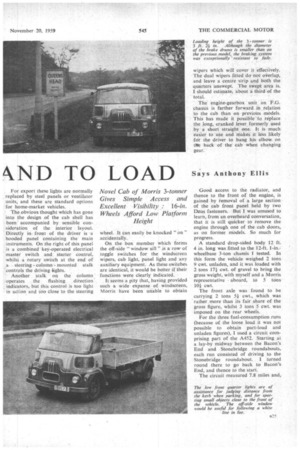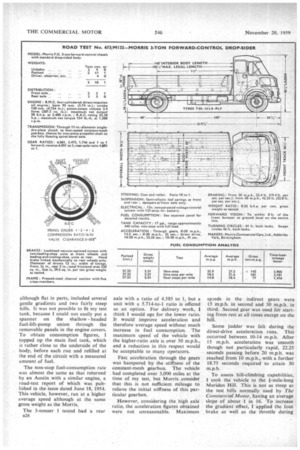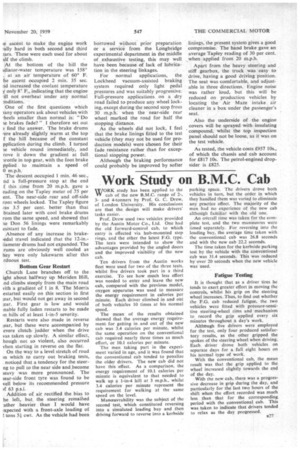EASY TO DRIN AiND TO LOAD Sys Anthony Ellis T HREE
Page 58

Page 59

Page 60

Page 61

If you've noticed an error in this article please click here to report it so we can fix it.
big advantages of the Morris F.G. . 3-to4 forwardcontrol -chassis are the ease of access to the cab, excellent visibility from the driver's seat, and a low load
ing height permitted by 16-in.-diameter wheels.
With these goes a fuel-consumption rate of nearly 26 m.p.g. at 27.5 m.p.h. non-stop fully laden. Acceleration is' not particularly exhilarating but adequate for delivery work, for which purpose the new range of 2-," 3and 4-ton chassis has been primarily designed. • The F.G. models (which are dupli
cated by the Austin Motor Co., Ltd.) were described in The Commercial Motor last week. All three vehicles in the new series have a number of corn
ponents used in the models they supersede. These include the B.M.C. 3.4 litre oil and 4-litre petrol engines, and the four-speed constant-mesh gearbox.
Detail refinements embrace more robust spiral-bevel rear axles for all models, and the addition of a vacuum servo to the braking system of the 3-tonner. This compensates for the reduction in brake-drum diameter caused by the fitting of small wheels. Although there is no radical development apparent in the chassis layout, the new models' cab design shines. Some people, including myself, find the cab exterior ugly at first, but few can find functional fault with it. I came to accept its rather curious styling during the day's testing, and certainly found no reason to change my opinion of its many practical qualities.
B24 Morris have adopted a novel approach to the problem of providing easy access to a forward-control driving position. Whereas an oftenapplied solution is to set the front axle back and provide a step ahead of the wheels, Morris have placed the cab doors behind the front wheels. The doors are at an angle on the rear quarters and really large rubbersurfaced steps are provided. These amount to vestigial running boards and are at the bottom of the trailing edges of the front wings. .
It is necessary to move around the right of the seat to reach the driving position, but this is not as difficult as it sounds. In fact, it needs little more effort than that required to reach the driver's seat in a good normal-control cab.
The angled doors are rear-hinged, and when open lie against the headboard of the standard drop-sided body. In this position they project only 2 in. outside the overall width of the vehicle, conferring obvious advantages in confined spaces. Although no retainers are provided to hold the doors open, it would be easy to fit catches.
These would allow the doors to be kept open while the vehicle was on the move to improve ventilation in hot weather, or to save time when the vehicle was engaged upon multi-stop work. When the doors are closed, their sliding windows act as Cinernascopic rear quarter-lights, providing excellent vision for reversing.
Forward vision from the driver's seat is to within 8 ft. of the front bumper 'on the centre line of the vehicle. Good though this is, it is only half the story. The windscreen has a large degree of wrap-round at the quarters. On the test vehicle, at least. there were no distortive effects.
The windscreen side pillars are thin, and between them and the doors are fixed triangular panes and swivelling quarter lights. The whole arrangement gives a remarkable spread of vision without any appreciable blind spots.
In addition, the lower front quarters incorporate curved glass panels, that on the near side aiding judgment of distance from the kerb when parking, whilst the off-side panel makes it easy to follow a white line in fog. For export these lights are -normally replaced by steel panels or ventilator units, and these are standard options for home-market vehicles.
The obvious thought which has gone into the design of the cab shell has been accompanied by sensible consideration of the interior layout. Directly in front of the driver is a hooded panel containing the main instruments. On the right of this panel is a combined key-operated electrical master switch and starter control, whilst a rotary switch at the end of asteering column mounted stalk controls the driving lights.
' Another stalk on the column . operates the flashing direction indicators, but this control is too light in action and too close to the steering wheel. It can easily be knocked " on " accidentally.
On the box member which forms the off-side "window sill" is a row of toggle switches for the windscreen wipers, cab light, panel light and any auxiliary equipment. As these switches are identical, it would be better if their functions were clearly indicated.
It seems a pity that, having provided such a wide expanse of windscreen, Morris have been unable to obtain wipers which will cover it effectively. The dual wipers fitted do not• overlap, and leave a centre strip and both the quarters unswept. The swept area is, I should estimate, about a third of the total.
The engine-gearbox unit on F.G. chassis is farther forward in relation to the cab than on previous models. This has made it possible to replace the long, cranked lever formerly used by a short straight one. It is much easier to use and makes it less likely for the driver to bang his elbow on dye back of the cab when changing gear.
Good access to the radiator, and thence to the front of the engine, is gained by removal of a large section of the cab front panel held by two Dzus fasteners. But I was amused to learn, from an overheard conversation, that it is still quicker to remove the engine through one of the cab doors, as on former models. So much for progress.
A standard drop-sided body 12 ft. 4 in. long was fitted to the 12-ft. 1-in.wheelbase 3-ton chassis I tested. In this form the vehicle weighed 2 tons 9 cwt. unladen, and it was loaded with 2 tons 171 cwt. of gravel to bring the gross weight, with myself and a Morris representative aboard, to 5 tons 10+ cwt.
The front axle was found to be carrying 2 tons 51 cwt., which was rather more than its fair share of the gross figure, whilst 3 tons 5 cwt. was imposed on the rear wheels.
For the three fuel-consumption runs (because of the loose load it was not possible to obtain part-load and unladen figures), I used a circuit comprising part of the A452. Starting at a lay-by midway between the Bacon's End and Stonebridge roundabouts, each run consisted of driving to the Stonebridge roundabout. I turned round there to go back to Bacon's End, and thence to the start The circuit measured 7.8 miles and, although flat in parts, included several gentle gradients and two fairly steep hills. It was not possible to fit my test tank, because I could not easily put a spanner on the shallow headed fuel-lift-pump union through the removable panels in the engine covers. To obtain consumption figures, I topped up the main fuel tank, which is rather close to the underside of the body, before each run and refilled at the end of the circuit with a measured amount of fuel.
The non-stop fuel-consumption rate was almost the same as that returned by an Austin with a similar engine, a road-test report of which was published in the issue dated June 18, 1954. This-vehicle, however, ran at a higher average speed although at the same gross weight as the Morris.
The 3-tonner I tested had a rear a26
axle with a ratio of 4.585 to 1, but a unit with a 5.714-to-1 ratio is offered as an option. For delivery work, I think I would opt for the lower ratio. It would improve acceleration and therefore average speed without much increase in fuel consumption. The maximum speed of the vehicle with the higher-ratio axle is over 50 m.p.h., and a reduction in this respect would be acceptable to many operators.
Fast acceleration through the gears was hampered by the stiffness of the constant-mesh gearbox. The vehicle had completed over 3,000 miles at the time of my test, but Morris consider that this is not sufficient mileage to relieve the initial stiffness of this particular gearbox.
However, considering the high axle ratio, the acceleration figures obtained were not unreasonable. Maximum speeds in the indirect gears were 15 m.p.h. in second and 30 m.p.h. in third. Second gear was used fdr starting from rest at all times except on the hill.
Some judder was felt during the direct-drive acceleration runs. This occurred between 10-14 m.p.h. After 15 m.p.h. acceleration was smooth though not particularly rapid, 22.25 seconds passing before 20 m.p.h. was reached from 10 m.p.h., with a further 18.75 seconds required to attain 30 m.p.h.
To assess hill-climbing capabilities, .1 took the vehicle to the +-mile-long Meriden Hill. This is not as steep as the test hills normally used by The Cominercial Motor, having an average slope of about 1 in 16. To increase the gradient effect, I applied the foot brake as well as the throttle during
ie ascent to make the engine work !ally hard in both second and third .!.ars. These were each used for about all the climb.
At the bottom of the hill the idiator-water temperature was 1580 . at an air temperature of 60° F. tie ascent occupied 2 min. 35 sec. id increased the coolant temperature y only 8° F., indicating that the engine ill not overheat under any normal 3nditions.
One of the first questions which iany operators ask about vehicles with 'heels smaller than normal is: "Do le brakes fade? " I therefore set out find the answer. The brake drums rere already slightly warm at the top f the hill because of the constant pplication during the climb. I tur,ned le vehicle round immediately, and rove it down the gradient at fullIrottle in top gear, with the foot brake pplied to maintain a speed of 0 m.p.h.
The descent occupied 1 min. 46 sec., nd a full-pressure stop at the end f this time from 20 m.p.h. gave a eading on the Tapley meter of 75 per ent. The near-side rear and off-side ront wheels locked. The Tapley figure ias 3.5 per cent. better than tha.t btained later with cool brake drums rom the same speed, and showed that 3e Don 56 linings were remarkably esistant to fade.
Absence of any increase in brakeedal travel indicated that the 12-in.liameter drums had not expanded. The rums are obviously well cooled as hey were only lukewarm after this rduous test.
Bottom Gear Restart
Church Lane branches off to the ight about halfway up Meriden Hill, .nd climbs steeply from the main road vith a gradient of 1 in 8. The Morris estarted easily on this section in first ;ear, but would not get away in second ;ear. First gear is low and would :milk fully laden restarts to be made in hills of at least 1-in-5 severity.
Restarts were also made in reverse ;ear, but these were accompanied by evere clutch • judder when the drive vas taken up slowly. A similar effect, hough not so violent, also occurred vhen starting in reverse on the flat. On the way to a level stretch of road m which to carry out braking tests, noticed that a tendency for the steerng to pull to the near side and become wavy was more pronounced. The tear-side front tyre was found to be yell below its recommended pressure if 63 p.s.i.
Addition of air rectified the bias to he left, but the steering remaihed .ather heavier than I would have :xpected with a front-axle loading of ! tons 5 cwt. As the vehicle had been
borrowed without prior preparation or a service horn the Longbridge experimental department in the middle of exhaustive testing, this may well have been because of lack of lubrication in the steering linkages.
For normal applications, the Lockheed vacuum-assisted braking system required only light pedal pressures and was suitably progressive. Full-pressure applications on a dry road failed to produce any wheel locking, except during the second stop from 30 m.p.h. when the near-side rear wheel marked the road for half the stopping distance.
As the wheels did not lock, I feel that the brake linings fitted to the test vehicle (they may not be used for production models) were chosen for their fade resistance rather than for exceptional stopping power.
Although the braking performance could probably be improved by softer linings, the present system gives a good *compromise. The hand brake gave an average Tapley reading of 30 per cent. when applied from 20 m.p.h.
Apart from the heavy steering and stiff gearbox, the truck was easy to drive, having a good driving position. The seat was comfortable, and adjustable in three directions. Engine noise was rather loud, but this will be reduced on production vehicles by locating the Air Maze intake air cleaner in a box under the passenger's seat.
Also the underside of the engine covers will be sprayed with insulating compound, whilst the top inspection panel should not be loose, as it was on the test vehicle.
As tested, the vehicle costs £957 10s., of which the chassis and cab account for £817 10s. The petrol-engined dropsider is £825.




































































































